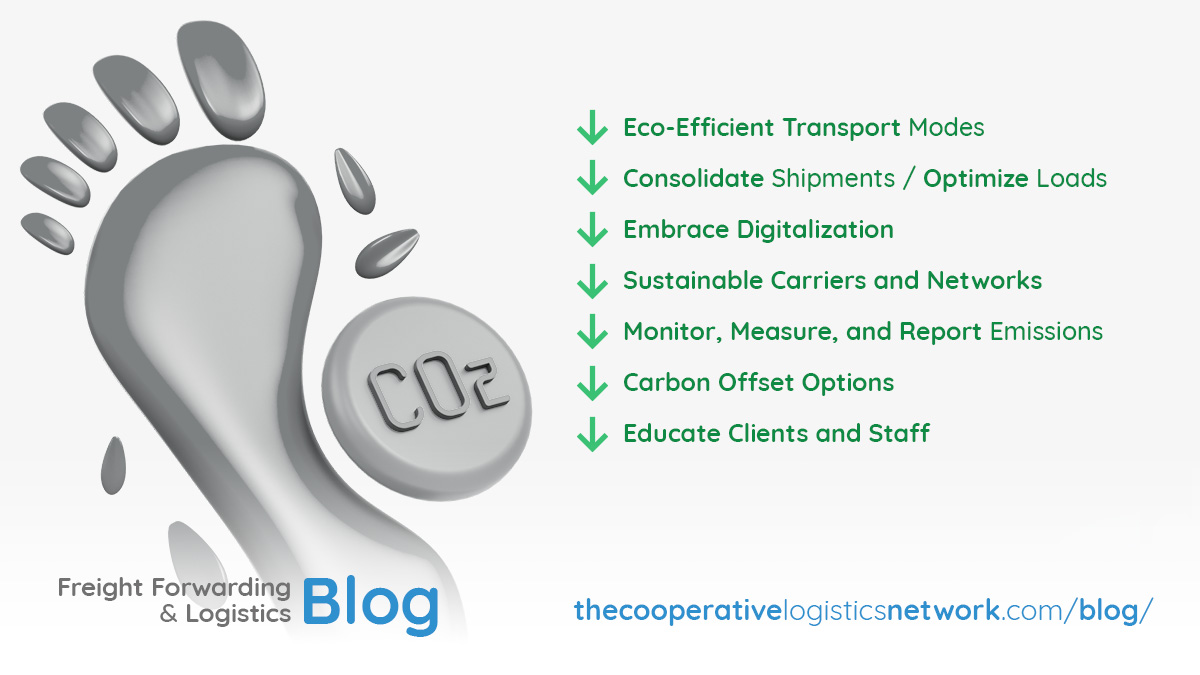In today’s global trade landscape, logistics professionals are under increasing pressure to deliver faster, cheaper, and—most critically—cleaner solutions. Climate change and environmental degradation are no longer distant concerns; they are immediate business challenges. For freight forwarders, this moment represents a major turning point. Sustainability is not just a buzzword—it’s a competitive advantage. Companies that fail to reduce emissions risk losing clients, while those that embrace green practices stand out in a crowded market. That’s where green freight forwarding comes in.

At its core, green freight forwarding is about making the movement of goods more environmentally responsible. It’s not about sacrificing service or profitability—it’s about optimizing supply chains, reducing waste, and building a resilient, future-ready business. And the good news? You don’t need to overhaul your entire operation overnight to make a difference. Sometimes, small, strategic changes can yield significant environmental and financial rewards. In this blog, we’ll walk you through seven simple yet powerful tips to help your freight forwarding business lower its carbon footprint and embrace greener practices.
Tip 1: Choose eco-efficient transport modes
The mode of transport you choose has a massive impact on emissions. Air freight, while fast, is also one of the most carbon-intensive methods. On the other hand, ocean freight and rail produce significantly fewer emissions per ton-kilometer. To practice green freight forwarding, consider recommending sea or rail transport whenever the delivery timeline allows. Better yet, look for intermodal options that combine different modes for maximum efficiency. While clients may request the fastest delivery by default, providing them with greener alternatives—and the environmental cost comparison—can encourage more sustainable choices.
Tip 2: Consolidate shipments and optimize loads
One of the simplest ways to reduce emissions is to make sure that containers and trucks are fully utilized. Half-empty shipments are wasteful, both economically and environmentally. Freight forwarders can work with clients and network partners to consolidate cargo, especially for less-than-container load (LCL) or less-than-truckload (LTL) shipments. This requires greater coordination and visibility across supply chains, but the payoff is significant: fewer trips, lower emissions, and more efficient use of resources. Adopting a green freight forwarding approach means treating every shipment as an opportunity to reduce unnecessary movement and maximize load efficiency.
Tip 3: Embrace digitalization to reduce waste
Digitization isn’t just about convenience—it’s also a sustainability tool. Paper documents, inefficient workflows, and manual processes are not only time-consuming, but they also generate unnecessary emissions and waste. By moving toward eB/Ls (electronic bills of lading), digital invoicing, online freight quote generation platforms, and automated customer service tools, forwarders can drastically cut down on paperwork, travel, and idle time. A digitally connected freight operation reduces energy consumption, lowers fuel use, and enables real-time decision-making. Green freight forwarding thrives in a paperless, data-driven environment where efficiency is the norm.
Tip 4: Partner with sustainable carriers
You’re only as green as your weakest link. In freight forwarding, you rely heavily on partners—carriers, agents, warehouses, and truckers—to move goods globally. That means your environmental impact is directly influenced by their practices. To truly embrace green freight forwarding, it’s essential to work with carriers and agents who are committed to sustainable logistics. Ask them about their emissions tracking, fleet upgrades, fuel efficiency programs, and carbon offset initiatives.
Tip 5: Monitor, measure, and report emissions
You can’t manage what you don’t measure. Carbon tracking tools have come a long way, and they are now accessible even to small and mid-sized freight companies. Start by calculating the emissions for each shipment, broken down by mode, distance, and fuel type. Share these insights with your clients—transparency builds trust and helps them make greener choices. Over time, this data can also help you identify inefficiencies and opportunities to improve. Incorporating carbon tracking into your daily operations is a key element of green freight forwarding, enabling you to set realistic targets and benchmark your progress.
Tip 6: Offer carbon offset options
Offsetting emissions is not the ultimate solution, but it’s a valuable part of a broader sustainability strategy. Many clients are now willing to pay a small premium to offset the environmental cost of their shipments, especially when it aligns with their corporate ESG goals. Freight forwarders can collaborate with certified offset providers to offer clients the chance to invest in reforestation projects, renewable energy, or clean transportation programs. This allows you to turn your services into a platform for climate action. By making offsets simple and transparent, you’re turning green freight forwarding into a collaborative effort between you and your clients.
Tip 7: Educate clients and staff about sustainability
Sometimes, your clients may not be aware of the environmental impact of their shipping choices. A key part of green freight forwarding is education—helping your clients understand how lead times, packaging, transport mode, and routing all affect emissions. At the same time, your internal teams—from operations to sales—should be trained on sustainable practices, carbon reduction goals, and how to communicate your company’s green value proposition. The more knowledgeable your team and clients are, the easier it becomes to integrate sustainability into your everyday workflows.
The bigger picture: Why green freight forwarding matters
Making your operations more sustainable isn’t just about compliance or checking a CSR box—it’s about future-proofing your business. Governments worldwide are tightening regulations. Clients are demanding greener supply chains. Investors are prioritizing ESG performance. The tide has shifted, and freight forwarders who ignore sustainability do so at their own peril. By adopting green freight forwarding practices now, you position your company as an industry leader—agile, responsible, and aligned with the values of tomorrow’s supply chains.
In the years ahead, carbon visibility will be as important as cost and transit time. Green freight forwarding is not a trend; it’s the new standard. And the forwarders who lead the way—offering data transparency, sustainable routing options, and emission-reducing strategies—will win more trust, more clients, and more business.
Final thoughts
Sustainability doesn’t require perfection—it requires progress. Whether you start by offering carbon tracking tools, consolidating shipments more efficiently, or simply digitizing your documentation process, every step counts. Green freight forwarding is about creating a smarter, cleaner, and more resilient logistics ecosystem—and it starts with the decisions you make today.
By embracing these seven simple tips, you’re not only lowering your carbon footprint—you’re future-proofing your freight forwarding company in an increasingly eco-conscious world.


